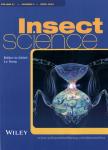Evolutionary genomics analysis reveals gene expansion and functional diversity of arylalkylamine N-acetyltransferases in the Culicinae subfamily of mosquitoes
作者机构:Laboratory of Tropical Veterinary Medicine and Vector BiologySchool of Life SciencesHainan UniversityHaikouChina One Health InstituteHainan UniversityHaikouChina Department of ChemistryUniversity of South FloridaTampaFloridaUSA
出 版 物:《Insect Science》 (昆虫科学(英文版))
年 卷 期:2023年第30卷第2期
页 面:569-581页
核心收录:
学科分类:0710[理学-生物学] 0830[工学-环境科学与工程(可授工学、理学、农学学位)] 07[理学] 08[工学] 09[农学] 0904[农学-植物保护] 071007[理学-遗传学] 0901[农学-作物学] 0836[工学-生物工程] 090102[农学-作物遗传育种] 0713[理学-生态学]
基 金:supported by the National Natural Science Foundation of China(31860702 and 31960703) by the Hainan Province Science and Technology Special Fund(ZDKJ2021035)
主 题:arylalkylamine N-acetyltransferase functional diversity gene duplication molecular evolution mosquito N-acyltransferase
摘 要:Arylalkylamine N-acetyltransferase(aaNAT),considered a potential new insecticide target,catalyzes the acetylation of arylalkylamine substrates such as serotonin and dopamine and,hence,mediates diverse functions in ***,the origin of insect aaNATs(iaaNATs)and the evolutionary process that generates multiple aaNATs in mosquitoes remain largely ***,we have analyzed the genomes of 33 species to explore and expand our understanding of the molecular evolution of this gene family in *** show that aaNAT orthologs are present in Bacteria,Cephalochordata,Chondrichthyes,Cnidaria,Crustacea,Mammalia,Placozoa,and Teleoste,as well as those from a number of insects,but are absent in some species of Annelida,Echinozoa,and Mollusca as well as ***,more than 10 aaNATs were detected in the Culicinae subfamily of *** evolutionary analysis of aaNAT/aaNAT-like genes in mosquitoes reveals that tandem duplication events led to gene expansion in the Culicinae subfamily of mosquitoes more than 190 million years *** selection analysis demonstrates that mosquito aaNATs evolved under strongly positive pressures that generated functional diversity following gene duplication ***,this study may provide novel insights into the molecular evolution of the aaNAT family in mosquitoes.



